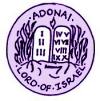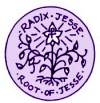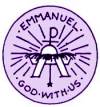And this will be a sign for you: you will find an infant wrapped in swaddling clothes and lying in a manger.”
And suddenly there was a multitude of the heavenly host with the angel, praising God and saying:
“Glory to God in the highest and on earth peace to those on whom his favor rests.”"
Luke 2:1-14
"I saw the radiance round the Blessed Virgin ever growing greater. The light of the lamps which Joseph had lit was no longer visible. The Blessed Virgin knelt on her rug in an ample ungirt robe spread out round her, her face turned towards the east.
At midnight she was rapt in an ecstasy of prayer. I saw her lifted from the earth, so that I saw the ground beneath her. Her hands were crossed on her breast. The radiance about her increased; everything, even things without life, were in a joyful inner motion, the stones of the roof, of the walls, and of the floor of the cave became as it were alive in the light. Then I no longer saw the roof of the cave; a pathway of light opened above Mary, rising with ever-increasing glory towards the height of heaven.
In this pathway of light there was a wonderful movement of glories interpenetrating each other, and, as they approached, appearing more clearly in the form of choirs of heavenly spirits. Meanwhile the Blessed Virgin, borne up in ecstasy, was now gazing downwards, adoring her God, whose Mother she had become and who lay on the earth before her in the form of a helpless newborn child. [100]
I saw our Redeemer as a tiny child, shining with a light that overpowered all the surrounding radiance, and lying on the carpet at the Blessed Virgin's knees. It seemed to me as if He were at first quite small and then grew before my eyes. But the movement of the intense radiance was such that I cannot say for certain how I saw it.
The Blessed Virgin remained for some time rapt in ecstasy. I saw her laying a cloth over the Child, but at first she did not touch Him or take Him up. After some time I saw the Child Jesus move and heard Him cry. Then Mary seemed to come to herself, and she took the Child up from the carpet, wrapping Him in the cloth which covered Him, and held Him in her arms to her breast. She sat there enveloping herself and the Child completely in her veil, and I think Mary suckled the Redeemer. I saw angels round her in human forms, lying on their faces and adoring the Child.
It might have been an hour after His Birth when Mary called St. Joseph, who was still lying in prayer. When he came near, he threw himself down on his face in devout joy and humility. It was only when Mary begged him to take to his heart, in joy and thankfulness, the holy present of the Most High God, that he stood up, took the Child Jesus in his arms, and praised God with tears of joy.
 |
| This excerpt is from this wonderful book which I am currently reading. TAN Books is the publisher. |
You can read more of Anna Catherine's writings. OR if you would like to purchase it for your home, you can visit TAN Books' Website.













 O Sapientia (December 17) O Wisdom (Eccl 24: 5), you came forth from the mouth of the Most High (Sir 24: 30), and reaching from beginning to end, you ordered all things mightily and sweetly (Wis 8: 1). Come, and teach us the way of prudence (Isa 40: 14).
O Sapientia (December 17) O Wisdom (Eccl 24: 5), you came forth from the mouth of the Most High (Sir 24: 30), and reaching from beginning to end, you ordered all things mightily and sweetly (Wis 8: 1). Come, and teach us the way of prudence (Isa 40: 14). O Adonai (December 18) O Adonai or O Lord and Ruler(Exod 6: 13) and Ruler of the house of Israel (Matt 2: 6), you appeared to Moses in the fire of the burning bush (Exod 3: 2), and on Mount Sinai gave him your Law (Exod 20). Come, and with outstretched arm redeem us (Jer 32: 21).
O Adonai (December 18) O Adonai or O Lord and Ruler(Exod 6: 13) and Ruler of the house of Israel (Matt 2: 6), you appeared to Moses in the fire of the burning bush (Exod 3: 2), and on Mount Sinai gave him your Law (Exod 20). Come, and with outstretched arm redeem us (Jer 32: 21). O Radix Jesse (December 19) O Root of Jesse, you stand for the ensign of all mankind (Isa 11: 10); before you kings shall keep silence and to you all nations shall have recourse (Isa 52: 15). Come, save us, and do not delay (Hab 2: 3).
O Radix Jesse (December 19) O Root of Jesse, you stand for the ensign of all mankind (Isa 11: 10); before you kings shall keep silence and to you all nations shall have recourse (Isa 52: 15). Come, save us, and do not delay (Hab 2: 3). O Clavis David (December 20) O Key of David (Apoc 3: 7) Scepter of the house of Israel, you open and no man closes; you close and no man opens (Isa 22: 22). Come, and deliver him from the chains of prison who sits in darkness and in the shadow of death (Ps 107: 10).
O Clavis David (December 20) O Key of David (Apoc 3: 7) Scepter of the house of Israel, you open and no man closes; you close and no man opens (Isa 22: 22). Come, and deliver him from the chains of prison who sits in darkness and in the shadow of death (Ps 107: 10). O Oriens (December 21) O Rising Dawn (Zac 6: 12), Radiance of the Light eternal (Hab 3: 4) and Sun of Justice (Mal 3: 20); Come, enlighten those who sit in darkness & the shadow of death (Ps 107: 10; Lk 1: 78).
O Oriens (December 21) O Rising Dawn (Zac 6: 12), Radiance of the Light eternal (Hab 3: 4) and Sun of Justice (Mal 3: 20); Come, enlighten those who sit in darkness & the shadow of death (Ps 107: 10; Lk 1: 78). O Rex Gentium (December 22) O King of the Gentiles(Hag 2: 8), Desired of all, you are the cornerstone that binds two into one (Eph 2: 20). Come, and save poor man whom you fashion out of clay (Gen 2: 7).
O Rex Gentium (December 22) O King of the Gentiles(Hag 2: 8), Desired of all, you are the cornerstone that binds two into one (Eph 2: 20). Come, and save poor man whom you fashion out of clay (Gen 2: 7). O Emmanuel (December 23) O Emmanuel (Isa 7: 14; 8: 8), our King and Lawgiver (Gen 49:10; cf. Ezek 21: 32), the Expected of the nations and their Savior (Isa 33: 22): Come, and save us, O Lord our God.
O Emmanuel (December 23) O Emmanuel (Isa 7: 14; 8: 8), our King and Lawgiver (Gen 49:10; cf. Ezek 21: 32), the Expected of the nations and their Savior (Isa 33: 22): Come, and save us, O Lord our God.










